|
Self-Teaching Unit:
Avoiding Fragments
© 2006, 2000, 1978 Margaret L.
Benner All rights reserved.
The sentence, like many other things, is a large
item composed of smaller items. Considered as a large
item, it is sometimes difficult to understand. Therefore, we will begin
with the smallest, simplest elements that make up a sentence,
gradually moving toward the large, more complicated ones.
WORDS
A
word
is the smallest part of speech and the easiest element of speech to recognize.
EACH GROUP OF LETTERS IN THIS SENTENCE IS A WORD.
There
are different kinds of words, according to the particular part a given
word plays when it is used in speech (writing or speaking).
To each kind of word we assign a label that shows which part of speech that word is.
As
you may already know, there are eight parts
of speech.
noun
verb
adverb
conjunction
pronoun
preposition
adjective
interjection
We
will consider three of them in this unit: noun, pronoun, and
verb.
NOUNS
A
noun names a person, place,
thing, or idea.
A
noun may name a type of person, place, thing, or idea.

Nouns
that are types are called common
nouns.
Or,
a noun may name a particular person, place, thing, or idea.

Nouns
that name particular persons, places, things, or ideas are proper
nouns. Proper nouns are
capitalized.
**NOTE:
Words that name ideas are sometimes hard to recognize as nouns because
they name
abstract ideas that we cannot see.
These are abstract
nouns (e.g. time, imagination, judgment, October, Saturday).
Even
though these words name things we cannot see, they are still nouns
because they name something.
Abstract proper nouns should also be capitalized.
PRONOUNS
A
pronoun
is a word that may substitute for a noun.
Some examples

Look at this sentence
 John Smith = noun
John Smith = noun
We
could substitute a pronoun (such as he)
for the noun.
 becomes
becomes 
Now look at this sentence



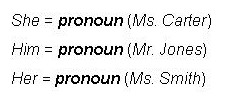
OR


A
verb
shows an action or a state
of being.
Action
verbs
are easy to recognize.
Some examples

This
sentence uses an action verb.

drew = action verb
Verbs
that show state of being indicate that something or someone exists.
Some examples

These
sentences use verbs
of being.


is
= verb
of being
will be = verb
of being
Now
click on the link below to do Exercise 1.
Link
to Exercise 1
Parts
of speech do not just sit idly about without any purpose. They have specific tasks to perform when they are put
together in a sentence.
Look
at this sentence.

There
are three nouns
in this sentence: philanthropists,
millions, and charity.
The
action
in this sentence is expressed by the verb – donated.
Although
there are three nouns in this sentence, only one of them is actually DOING the
action of donating:
philanthropists.
Philanthropists donated…
We
could also express this same idea with a pronoun.

Here
the pronoun
they is DOING the action of
donating.
They donated…
The
two sentences above illustrate a rule of sentence structure:
When
a noun or pronoun is partnered with a verb so that the noun or pronoun is doing
the action expressed by that verb, we call that noun or pronoun the verb’s
SUBJECT.
Look
at this sentence.

The
verb in this sentence -- are – does not express action.
Instead,
it expresses being or existence
– tells us that something is alive.
Still,
as in the earlier sentences, there is a noun paired with this verb.
That noun is the one DOING the existing
or being:
friends.
Good friends are…
This
noun – friends – is the subject of the verb
are
in this sentence.
As
we did with the action verb example, we could substitute a pronoun for the noun, friends,
in this sentence.
Knowing
that verbs can express either action or being, we can now expand our rule.
When
a NOUN or PRONOUN is paired with a verb so that the noun or pronoun is doing the
action or the being expressed by the verb, we call that noun or pronoun the
verb’s SUBJECT.
**SPECIAL NOTE:
Sometimes
we use sentences in which a subject is not
actually stated, but
is,
nevertheless,
understood in the meaning.
Example

A
sentence like this gives an order or a request to someone.
What
we really mean when we make such requests is shown in the sentence below.

You,
as the DOER of the action verb, call,
is the SUBJECT here.
Because
we use such statements when we are talking directly to someone, we usually omit
the word you. We consider it unnecessary – understood
in the sentence.
Therefore,
in statements such as -- Call the plumber,
please -- we say that the
subject is
you
(understood)
 you
(understood) = subject
you
(understood) = subject
This
kind of sentence is called an imperative
sentence.
Now click on the link below to
complete Exercise 2.
Link to Exercise 2
Now
you know how to locate the subject in a noun-verb partnership: look for the noun
(or pronoun) that is DOING the action
or the being expressed by the
verb.
The
verb in this noun-verb partnership also has a job to do.
It functions as the action
or as the being
that the subject is DOING.
Look
at these examples.
1.

2.

We
already know that the noun philanthropists,
the DOER of the action, donated,
is the subject
of the noun-verb partnership, philanthropists
donated
(example #1).
We
also know that the noun friends
is the subject of the noun-verb partnership,
friends are (example
#2).
These
verbs – donated and are – also perform a specific task in this noun-verb partnership: they
express the subject’s action or state of being.
We
call a verb that performs this function a predicate.
 Philanthropists
= subject Philanthropists
= subject
donated
= predicate
 friends
= subject
friends
= subject
are = predicate
 you
(understood)
= subject
you
(understood)
= subject
call = predicate
The
verbs in the sentences below are also doing the job of a predicate.
 they
= subject
they
= subject
donated
= predicate
 they
= subject
they
= subject
are
= predicate
This
information leads us to a rule:
The
VERB in a noun/pronoun – verb partnership expressing the action
or being of the subject is a
PREDICATE.
Sometimes
the predicate will be composed of two or
three verbs that fit together --
the main
verb preceded by one of more helping verbs.
Helping
verbs
(also called auxiliary verbs) help the main verb to form its tense
(time) or to emphasize its action. They
always come BEFORE the main verb.
Note
how helping verbs change the tense (time)
of each main verb below.
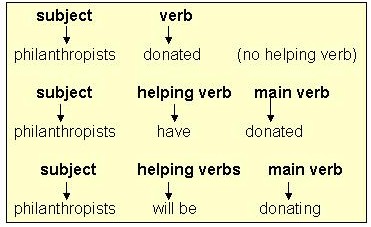
IMPORTANT
NOTE: To be a predicate, a verb that ends in –ing must ALWAYS have a helping
verb
with it. An –ing
verb WITHOUT a helping verb cannot
be a predicate
in a sentence.
More
About Predicates
A
predicate usually follows the subject,
but it may be separated from the
subject by one or more words.
Look
at this sentence.

Even
though hillside
is
next to the verb howled,
it is not the subject here because it is not
DOING the howling.
The dog is.
Sometimes
the verbs
in the predicate may be separated from
one another.
Look
at these sentences.
1.

The word often is an adverb, not a
helping verb. The predicate is has howled.
2.
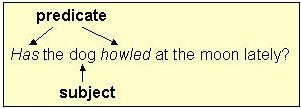
Example
#2 illustrates that when we form questions,
we sometimes make the subject separate
the helping
verbs from the main
verb.
When
separations like #1 and #2 occur, don’t be alarmed or confused. Just remember the rules for finding the subject and
predicate. You should have no
difficulty at all.
In
some cases as well, the subject may NOT DO the action
of the predicate, but may, instead, be acted upon by the predicate.
Example
 office
= subject
office
= subject
was
destroyed
= predicate
NOTE
that the noun, office,
is NOT the DOER of the action (was
destroyed).
Instead,
office
is being acted
upon (is being destroyed) by
some unknown DOER.
In
such a case, office
is still the subject
of the predicate was
destroyed.
Even
when the DOER of the action is known,
it is not the subject unless it is working in a partnership
with the verb.
Example
 office
= subject
office
= subject
was
destroyed
= predicate
Vandals
is NOT the sentence’s subject because vandals
is not working in a partnership
with the verb was
destroyed.
We
use the term passive
voice to refer to the predicate in this kind of subject-verb
partnership.
SOME
FINAL WORDS . . .
The
terms subject
and predicate
can be applied ONLY where there is a noun-verb partnership, where the noun and
verb interact with one another to create the topic of the sentence.
You
will NEVER see a subject sitting
alone without a predicate (although you may see a noun sitting alone without a
verb.)
You
WILL see a predicate sitting alone
without a subject ONLY when the
subject is you (understood).
In
order to be a predicate, a verb ending in –ing
MUST HAVE a helping
verb.
REVIEW
OF SUBJECT – PREDICATE TRICKY SPOTS:
1.
You
(understood) subject

2.
Subject separated from predicate

3.
Parts of predicate (helping verb /
main verb) separated by adverb

4.
Subject – predicate order
changed in a question

5.
Subject – predicate pair in
passive voice

Now
click on the link below to do Exercise 3.
Link
to Exercise 3
Now
that you understand nouns/pronouns, verbs, subjects, and predicates (WORDS), you
are ready to move up to a larger segment: phrases.
A
phrase
is a group of words which may contain noun/pronouns or verb forms, but
does NOT contain a subject
or a predicate.
**REMEMBER:
Every subject has a predicate, and every predicate has a subject. These two functions never appear without each other.
They form a partnership, a team.
Some
examples of PHRASES:
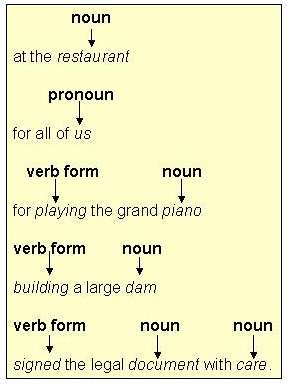
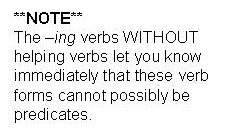
Even
though these phrases contain nouns (pronouns) or
verb forms, or both nouns (or pronouns) and
verb forms, none of the
nouns/pronouns/verbs have the qualifications needed to be subjects or predicates.
None of them work as a partnership – as a team.
Also,
these phrases
do NOT seem to say anything complete
either.
These
findings lead to a definition of the phrase:
A phrase is a group of
related words that
1.
does not express a complete
thought
Now click on the link below to
do Exercise 4.
Link to EXERCISE 4
We
can now look at a more complicated concept: clauses.
Words
and phrases can be put together to
make clauses.
Like
a phrase,
a clause is a group of related words.
Unlike
a phrase,
a clause DOES contain a subject and predicate.
Note
the difference between phrases and clauses in the following examples:
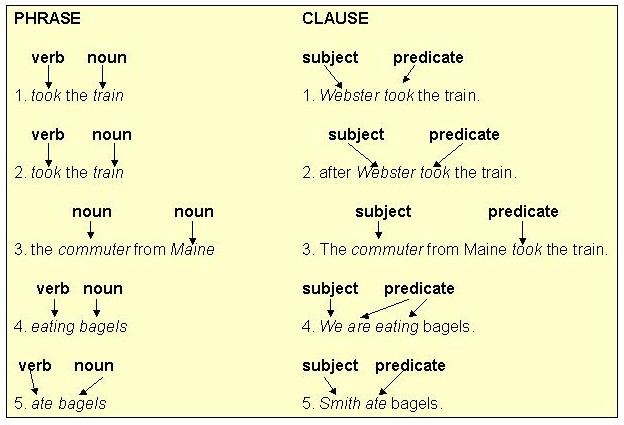
The
words below are a phrase, NOT a clause.
This means that the noun, Smith,
is NOT a subject and that the verb
form, eating, is NOT a predicate.
Why can’t these two words possibly be subject and predicate?
You
probably noticed that, of the five clause
examples given earlier in Section 5, only three were sentences (#1,
3, 4).
Look
back at all five clause
examples. Read each one to
yourself.
Did
you notice any difference in the meaning
between the three clauses that ARE sentences (#1,
3, 4) and the two clauses (#2, 5)
that are NOT sentences?
Yes,
there is a difference!
Clauses
#1, 3, and 4 give a thought or an idea that is COMPLETE, that can stand by
itself, independent of other words.
However,
clauses #2 and 5 give only an INCOMPLETE thought or idea, one that cannot stand independent by itself, one that needs some more words
to make it whole.
To
see the difference, look at clauses #1 and 2 copied below for you.
1.

This
clause tells us what happened and who made it happen.
Its thought is COMPLETE and finished.
We are not left “hanging” or asking questions after a clause like
this one
2.

This
clause tells us what happened and who made it happen, BUT its thought is NOT
complete.
The
word
after
changes the clause meaning, making it INCOMPLETE.
After
reading this clause, we are left “hanging” – left waiting for it to be
finished. This clause raises a
question: What happened after Webster took the train?
These
two clauses illustrate the two kinds of clauses we use in the English
language:
independent clauses and
dependent
clauses
Clause
#1

Clause
#1
has these three characteristics:
1. subject 2.
predicate
3. complete
thought
This
kind of clause is called an independent clause or a main
clause. It is a complete
unit by itself and does NOT need or depend upon any other words for its
completeness.
FOR
YOUR INFORMATION . . .
AN
INDEPENDENT CLAUSE AND A SIMPLE SENTENCE ARE THE SAME THING.
Clause
#2

Clause
#2
has these three characteristics:
1. subject
2. predicate
3. incomplete
thought
This
kind of clause is called a dependent clause or a subordinate
clause. It is an incomplete
unit on its own, leaving its reader asking questions.
It needs or depends on additional words to be a complete thought.
We
can now formulate a definition for
each type of clause:
An
independent
clause is a group of words that contains a subject, a predicate, and a
complete thought.
A
dependent
clause is a group of words that contains a subject and a predicate, but
does NOT express a complete thought.
Now
click on the link below to do Exercise 5.
Link to Exercise 5
You
have now reached the main focus of this unit: writing
complete sentences.
You
will be happy to know that while you have been progressing from word to phrase to clause,
you have actually already been teaching yourself about sentence structure!
Here’s
the good news. In order to have a sentence,
you need only TWO elements:
1. a subject-predicate unit
AND
2. a complete thought
 citizens
= subject citizens
= subject
protested
= predicate
complete
thought? yes
In
other words, a simple
sentence is actually the SAME thing as an independent clause.
Since you already know what an independent clause is, you can also
understand immediately what a simple sentence is.
SIMPLE SENTENCE
=
INDEPENDENT
CLAUSE
 = =

Therefore,
as long as you remember what constitutes an independent clause, you will
automatically recognize what constitutes a simple sentence.
REMEMBER:
subject -- predicate pair + complete thought = simple sentence
BACK
TO DEPENDENT CLAUSES AND PHRASES
FOR A MOMENT . . .
Dependent
clauses and phrases are called sentence fragments
because they are missing one or more
parts needed to make a sentence (subject/predicate pair & complete thought)
and are, therefore, only pieces or fragments of complete sentences.
Look
at these examples
1.
 =
= 
2.
 = = 
3.
 =
= 
4.
 =
= 
Examples
2, 3, and 4 are fragments, not complete sentences, because they are missing at
least one element needed to construct a complete sentence.
Except
in rare instances, fragments are MAJOR WRITING ERRORS. Try not to use fragments in your writing.
Use complete sentences instead.
Now
click on the link below to do Exercise 6.
Link to Exercise 6
You
have now reached the end of this unit.
If
you are doing this module on your own, you have completed the learning unit
on avoiding fragments..
If
you are doing this module as part of your classroom assignment, proceed to the
Post Test and follow the directions you find there.
Click
on the link below to do the Post Test.
Link to
the Post
Test
|